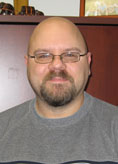|
Additional Contact Information: Department of Biomedical Sciences |
A third project, in collaboration with Dr. David Williams (Surgery-ETSU) is on the
role of glucans and how they are recognized by the host. Glucans from several fungal
sources are being purified and characterized for their structure and used with in vitro and in vivo models to understand host recognition and response to fungal carbohydrates.
EDUCATION/PROFESSIONAL EXPERIENCE
1988-1992 - B.S. St. Marys University, San Antonio, Texas, Department of Biology1994-2000 - Ph.D. University of Texas Health Science Center at San Antonio, Department of Microbiology & Immunology
2000-2005 - Postdoctoral Fellow, Georgetown University Medical School (GUMC) Department of Microbiology & Immunology.
2005-2007 - Research Assistant Professor (GUMC)
2008- Present Assistant Professor in the Department of Microbiology (Biomedical Sciences since 2012) at ETSU
RESEARCH/TEACHING INTERESTS
My Laboratory has several ongoing research projects. My primary research interest
is understanding the mechanism of how the opportunistic fungus Candida albicans regulates its ability to undergo morphogenesis through a process called quorum sensing.
Quorum sensing in C. albicans is due to the expression of a molecule called farnesol. As farnesol is expressed,
the increasing concentration of the molecule inhibits the ability of the organism
to undergo morphogenic shift from a yeast growth form to that of a hyphal growth form.
The ability to sense farnesol and control morphogenesis contributes to the ability
of C. albicans to be virulent in a host organism. Ultimately our goal is to understand how this
process works and to develop new molecules that target the quorum sensing regulatory
pathway(s) as possible new antifungal compounds.
A second project that is an off-shoot from C. albicans quorum sensing, is investigating how the fungus interacts with other microbial species
as a reflection of interspecies communication relating to control of C. albicans morphogenesis. We are interested in understanding the interspecies interactions
that take place in clinically important niches, both in the host and on abiotic surfaces
in the form of biofilms. Biofilms are a major source for hospital acquired infections
and are rather resistant to antimicrobials, and understanding how the microbial communities
that make up these biofilms communicate and compete for space may help give clues
as to how microbes can persist and survive antibiotic treatment.
SELECTED PUBLICATIONS
- Li, D., Williams, D., Lowman, D., Monteiro, M.A., Tan, X., Kruppa, M., Fonzi, W., Roman, E., Pla, J., and R.Calderone. 2009. The Candida albicans histidine kinase Chk1p: Signaling and cell wall mannan. Fungal Gen Biol. 731-741.
- Kruppa, M.D., Lowman, D., Chen,Y-H., Selander, C., Scheynius, A., Monteiro, M.A., and D. L. Williams. 2009.Identification of (16)--D-glucan as the major carbohydrate component of the Malassezia sympodialis cell wall. Carbohydr Res.2474-2479.
- Bambach, A., Fernandes, M., Ghosh, A., Kruppa, M., Alex, D., Li, D., Fonzi, W., Chauhan, N., Sun, N., Agrellos, O., Vercesi, A., Rolfes,
R.J., and R. Calderone. 2009. The Goa1p of Candida albicans localizes to the mitochondria during stress and is required for mitochondrial function
and virulence. Eukary Cell.1706-1720.
- Kruppa, M. 2009. Quorum Sensing and Candida albicansMycoses. 52:1-10
- Kruppa, M., Greene, R.R., Noss. I, Lowman, D.W., and D. L. Williams. 2011. C. albicans increases cell wall mannoprotein, but not mannan, in response to blood, serum and cultivation at physiological temperature. Glycobiol.21(9):1173-80.
- Lowman, D. W. , West, L. J., Bearden, D. W., Wempe, M. F. , Power, T.D. , Ensley, H. E., Haynes, K. , Williams, D. L. and M. D. Kruppa. 2011. New insights into the structure of (13,16)--D-glucan side chains in the Candida glabrata cell wall. PLoS One 6(11):e27614.
- Lowman, D. W., Ensley, H. E. , Greene, R. R. , Knagge, K. J. , Williams, D. L. and M. D. Kruppa. 2011. Mannan structural complexity is decreased when Candida albicans is cultivated in blood or serum at physiological temperature. Carbohydr Res. 346(17):2752-9.
- Hall, R. A., Bates,S., Lenardon,M.D., MacCallum, D.M., Lowman,.W., Kruppa,M.D., Williams,D.L., Odds,F.C.,Brown,A.J.P., and N.A.R. Gow. 2013. The Mnn2 mannosyltransferase family modulates mannoprotein fibril length, immune recognition and virulence of Candida albicans. PLoS Pathog. 9(4): e1003276.
- Fox,S.J., Shelton, B.T., and M. D. Kruppa. 2013. Characterization of Genetic Determinants that modulate C. albicans Filamentation in the Presence of Bacteria. PloS ONE 8(8): e71939. doi:10.1371/journal.pone.0071939.
- Lowman D.W., Greene,R.R., Bearden,D.W., Kruppa, M.D., Pottier, M., Monteiro, M.A., Soldatov, D.V.,Ensley,H.E.,Cheng,S.S., Netea, M.G., and D. L. Williams 2014. Novel structural features in Candida albicans hyphal glucan provide a basis for differential innate immune recognition of hyphae versus yeast. J. Biol Chem. 289(6):3432-43.
 South Dossett Drive - Closure...
South Dossett Drive - Closure... 